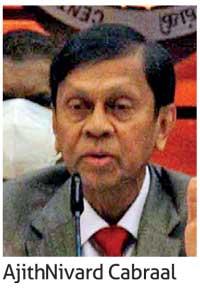26 Jan 2022 - {{hitsCtrl.values.hits}}
Following the repayment of half a billion dollar bond last week, the Central Bank Governor Ajith Nivard Cabraal this week expressed confidence in settling the billion dollar sovereign bond maturing this July.
 He said the breathing space that will come with the retirement of sovereign bonds would be utilised to rebuild the reserves and the resilience of the external sector with non-debt creating inflows and monetisation of some State-owned assets.
He said the breathing space that will come with the retirement of sovereign bonds would be utilised to rebuild the reserves and the resilience of the external sector with non-debt creating inflows and monetisation of some State-owned assets.
Speaking to CNBC International, an around the clock global news channel on business and financial markets, Cabraal stressed Sri Lanka is already restructuring its foreign currency debt without International Monetary Fund (IMF) assistance and that is proving sustainable.
“Out of the US$ 6.9 billion (Fx debt due for 2022), most of these loans are Sri Lanka based loans, which we have been negotiated already for rollover as well as certain multilateral debt which are also being funded with new receipts that are coming in. So, we don’t really see too much of a risk there,” Cabraal said.
“The only area we do see some kind of risk as well as concern is the international sovereign bonds (ISBs), out of which we need to pay US$ 1.5 billion back this year. We have already paid US$ 500 million and we have one more billion to be paid,” he added.
When the new government came into power, it took a conscious policy decision to gradually reduce Sri Lanka’s exposure to ISBs, which typically makes the country vulnerable to external sector shocks.
The pandemic-induced market tumult, and the subsequent sovereign rating downgrades also impaired the country’s access to international capital markets to rollover its maturing ISBs, which enabled the government to reduce its exposure to ISBs in the total public debt, though with fresh external
sector pressures.
As a result, the government has reduced its ISB exposure of the total public debt by 17 percent to US$ 12.5 billion in the last two years and the reduction in the exposure would go up to 23 percent by July, when Sri Lanka settles the US$ 1 billion maturing bond.
“We have already made arrangements to pay back the next loan; we are funding that with alternative sources,” he said.
These comments by Cabraal infused confidence to the markets, which were somewhat skittish on the country’s shaky external sector position until recently.
A section of economists however have been urging the authorities to seek IMF assistance to restructure the remaining debt in the aftermath of the January bond settlement.
The Indian credit lines totalling approximately US$ 2.5 billion, swap lines and bi-lateral funding lines under negotiation could provide the country with some breathing space until its non-debt creating inflows, which the Central Bank keeps harping on, are materialised in the coming months. Cabraal is confident that the country would be able to ride out the current foreign exchange and economic troubles with its current strategy that is already delivering results.
“We have made sure that these (ISBs) are being financed with new sources, which allows us to settle the ISB loans and get the breathing space as you quite rightly mentioned, which allows us thereafter to take new steps to increase our earnings as well as have new non-debt creating inflows. We are also monetising certain assets,” he said.
“Through that strategy we will be able to have a lot more sustainable debt portfolio and that’s what we are aiming for,” Cabraal added.
24 Nov 2024 4 hours ago
24 Nov 2024 5 hours ago
24 Nov 2024 5 hours ago
23 Nov 2024 23 Nov 2024
23 Nov 2024 23 Nov 2024